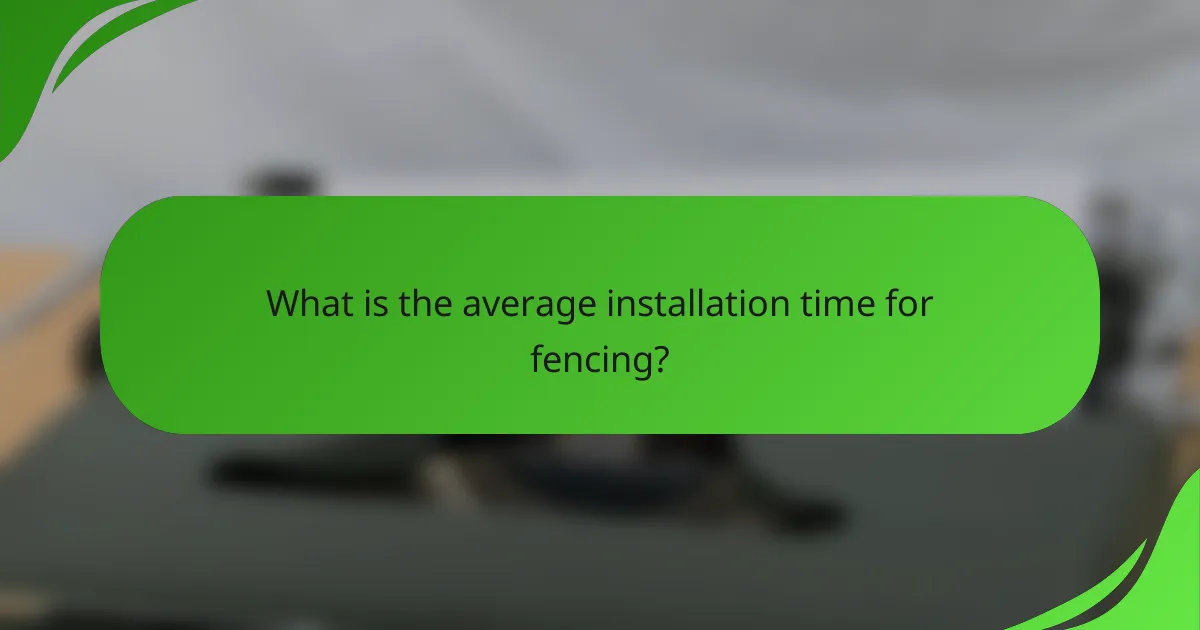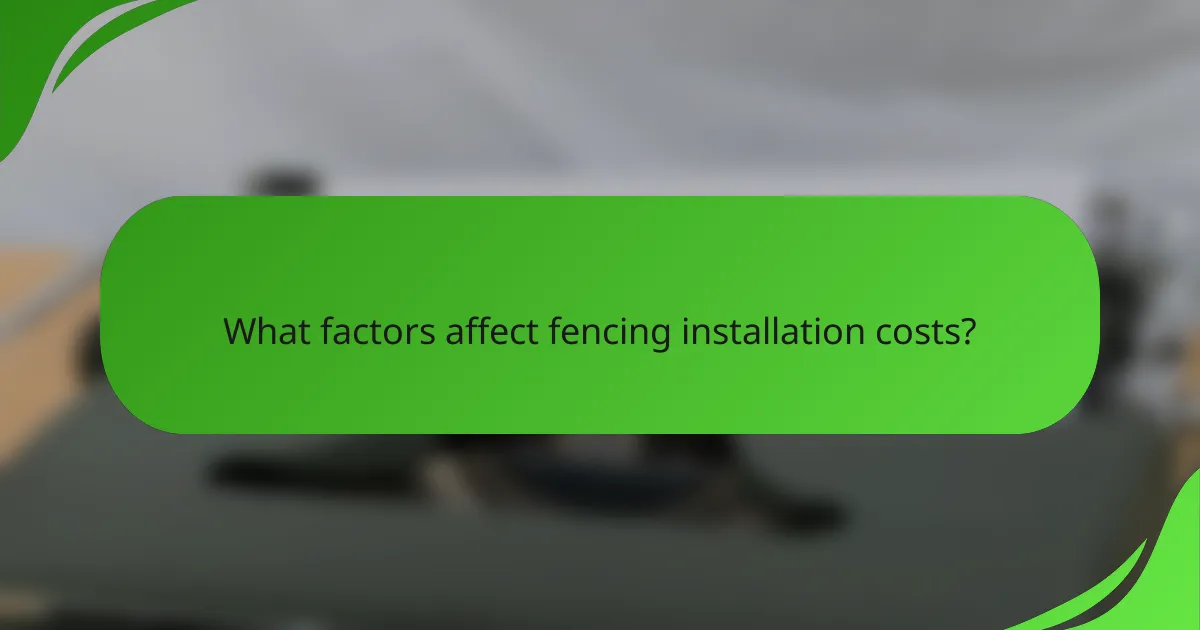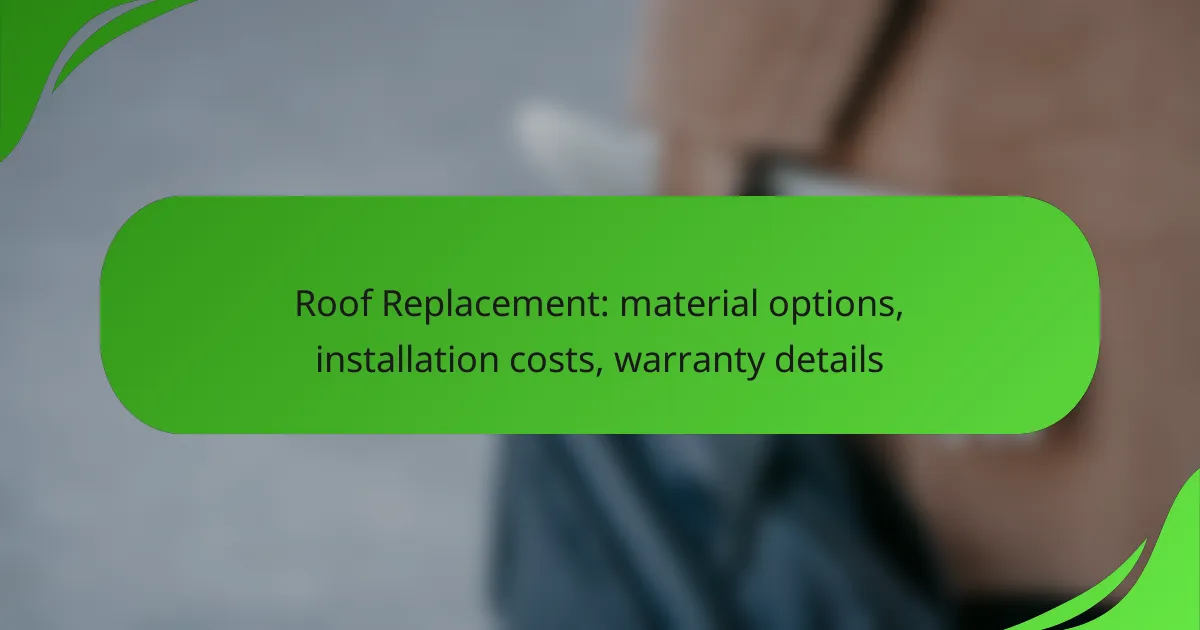When considering fencing installation, it’s essential to evaluate various materials such as wood, vinyl, chain link, aluminum, and composite, each offering unique benefits and challenges. The overall cost can range widely, influenced by local labor rates and material choices, while installation time typically spans from a few hours to several days based on project complexity. Understanding these factors will help you make informed decisions for your fencing project.

What are the best fencing materials for installation in the USA?
The best fencing materials for installation in the USA include wood, vinyl, chain link, aluminum, and composite. Each material has its own advantages and considerations, affecting factors like cost, durability, and maintenance.
Wood fencing
Wood fencing is a popular choice for its natural appearance and versatility. Common types include cedar, pine, and redwood, with costs typically ranging from $15 to $30 per linear foot, depending on the type and quality of wood.
When installing wood fencing, consider the local climate, as moisture and pests can affect longevity. Regular maintenance, such as staining or sealing, is essential to prevent decay and extend the fence’s life.
Vinyl fencing
Vinyl fencing offers a low-maintenance alternative to wood, with prices generally between $20 and $40 per linear foot. It is available in various styles and colors, providing aesthetic flexibility while resisting fading and rotting.
Installation of vinyl fencing is straightforward, often requiring fewer tools than wood. However, ensure proper anchoring in windy areas, as lighter materials can be susceptible to damage from strong gusts.
Chain link fencing
Chain link fencing is an economical option, typically costing between $10 and $20 per linear foot. It is durable and provides good visibility, making it suitable for security and boundary purposes.
While chain link requires minimal maintenance, consider adding privacy slats or vinyl coating for enhanced aesthetics and privacy. Installation is usually quick, often completed in a day for standard residential projects.
Aluminum fencing
Aluminum fencing combines durability with a sleek appearance, usually priced between $25 and $40 per linear foot. It is resistant to rust and corrosion, making it ideal for various climates.
Aluminum fencing is often used for decorative purposes and pool enclosures. Ensure proper installation to maintain structural integrity, as it can be less forgiving than other materials in high-stress situations.
Composite fencing
Composite fencing, made from a blend of wood fibers and plastic, typically costs between $25 and $45 per linear foot. It offers the look of wood with enhanced durability and lower maintenance requirements.
This material is resistant to rot, insects, and fading, making it a long-lasting option. However, ensure proper ventilation during installation to prevent moisture buildup, which can lead to warping over time.

How much does fencing installation cost in major US cities?
The cost of fencing installation varies significantly across major US cities, typically ranging from a few hundred to several thousand dollars depending on materials and labor. Factors such as local labor rates, material availability, and specific project requirements will influence the final price.
Cost of wood fencing installation
Wood fencing installation generally costs between $15 and $30 per linear foot, depending on the type of wood and design complexity. Pressure-treated pine is often the most affordable option, while cedar and redwood can be more expensive but offer greater durability and aesthetic appeal.
When planning for wood fencing, consider maintenance costs, as wood requires regular staining or sealing to prevent rot and weather damage. Local building codes may also dictate specific requirements for wood fencing, so check with local authorities before installation.
Cost of vinyl fencing installation
Vinyl fencing installation typically ranges from $20 to $40 per linear foot. This material is popular for its low maintenance and long lifespan, as it does not require painting or staining. However, the initial investment is usually higher than wood fencing.
Vinyl fences come in various styles and colors, allowing for customization. Be aware that while vinyl is durable, extreme temperatures can affect its integrity, so consider your local climate when choosing this material.
Cost of chain link fencing installation
Chain link fencing is one of the most cost-effective options, with installation costs averaging between $10 and $20 per linear foot. This type of fencing is ideal for security and visibility, making it a popular choice for commercial properties and residential backyards.
While chain link fences are affordable, they may not provide the same aesthetic appeal as wood or vinyl options. Consider adding privacy slats or vinyl coating for enhanced appearance and functionality, which can increase overall costs.
Cost of aluminum fencing installation
Aluminum fencing installation costs typically range from $25 to $40 per linear foot. This material is lightweight, resistant to rust, and offers a sleek appearance, making it suitable for decorative purposes as well as security.
Aluminum fences often come in pre-fabricated panels, which can simplify installation. However, they may require a higher upfront investment compared to other materials. Ensure that the design meets local zoning regulations, especially if the fence is intended for pool enclosures or property boundaries.

What is the average installation time for fencing?
The average installation time for fencing varies based on the material and complexity of the project. Generally, you can expect installation to take anywhere from a few hours to several days, depending on factors such as the type of fencing, site conditions, and crew experience.
Installation time for wood fencing
Wood fencing typically requires more time to install due to its construction process. On average, a standard wood fence can take 1 to 3 days to complete, depending on the size of the area and the number of panels. Factors such as weather conditions and the need for custom cuts can also affect the timeline.
When planning for wood fencing installation, consider that posts need to be set in concrete, which may require additional curing time. It’s advisable to allow for flexibility in your schedule to accommodate these factors.
Installation time for vinyl fencing
Vinyl fencing installation is generally quicker than wood, often taking 1 to 2 days for a standard-sized yard. The panels are pre-manufactured, which simplifies the process, but proper measurements and leveling are crucial for a successful installation.
Keep in mind that while vinyl fencing can be installed relatively quickly, the initial setup, including post placement and concrete setting, still requires careful attention to detail to ensure durability.
Installation time for chain link fencing
Chain link fencing is one of the fastest types to install, often completed in a single day for a typical residential yard. The lightweight materials and straightforward assembly process contribute to its quick installation time.
However, preparation is key; ensuring the ground is level and marking the layout beforehand can help streamline the process. If you are installing a larger area or adding gates, allow for additional time to accommodate these elements.

What factors affect fencing installation costs?
Fencing installation costs are influenced by several key factors, including labor costs, material quality, and site preparation. Understanding these elements can help you budget effectively and make informed decisions about your fencing project.
Labor costs
Labor costs typically account for a significant portion of the total fencing installation expense. Rates can vary widely based on location, with urban areas often seeing higher prices due to demand and cost of living. On average, you might expect to pay between $30 to $70 per hour for professional installers.
When hiring a contractor, consider obtaining multiple quotes to ensure competitive pricing. Be wary of extremely low bids, as they may indicate subpar workmanship or hidden costs.
Material quality
The quality of fencing materials directly impacts both the initial cost and long-term durability. Common materials include wood, vinyl, chain link, and metal, each with varying price points and maintenance requirements. For instance, while wood may be cheaper upfront, it often requires more maintenance and replacement over time compared to vinyl or metal options.
Investing in higher-quality materials can lead to lower overall costs in the long run due to reduced maintenance and replacement needs. Always consider the lifespan and warranty of materials when making your choice.
Site preparation
Site preparation is a crucial factor that can significantly affect installation costs. If the area is overgrown, uneven, or contains obstacles like rocks or trees, additional labor and equipment may be required to clear the site. This can add to the overall expense, sometimes by hundreds of dollars.
Before installation, assess the site conditions and address any potential issues. Simple tasks like clearing debris or leveling the ground can save time and money during the installation process. If extensive preparation is needed, factor this into your budget early on to avoid surprises.

What are the prerequisites for fencing installation?
Before installing a fence, it’s essential to understand the prerequisites, which include local zoning regulations, property lines, and necessary permits. These factors ensure compliance with local laws and help avoid disputes with neighbors.
Local zoning regulations
Local zoning regulations dictate where and how fences can be installed on your property. These rules can vary significantly by municipality, so it’s crucial to check with your local zoning office before proceeding.
Common regulations may include height restrictions, material specifications, and setback requirements from property lines. For example, some areas may allow fences up to 6 feet tall in backyards but limit front yard fences to 4 feet.
To ensure compliance, obtain any required permits and consider consulting with a professional if you’re unsure about the regulations in your area. This can save you time and money by preventing potential fines or the need to remove non-compliant installations.









